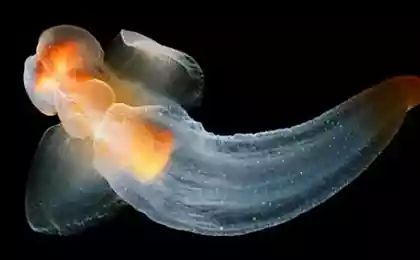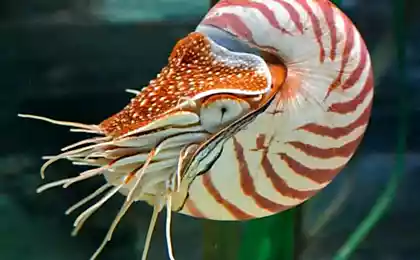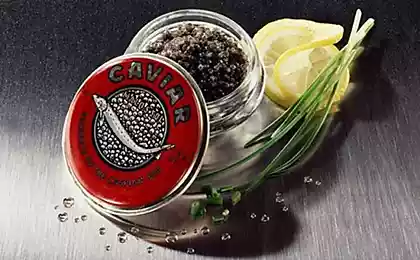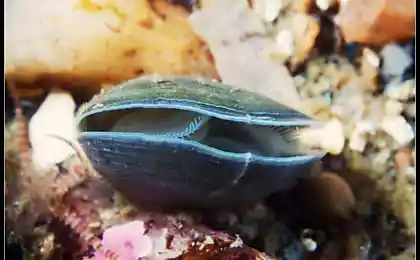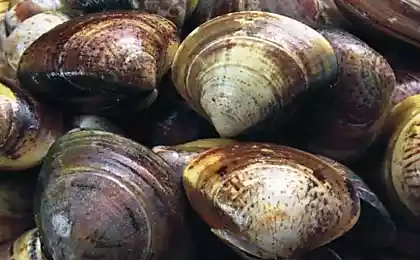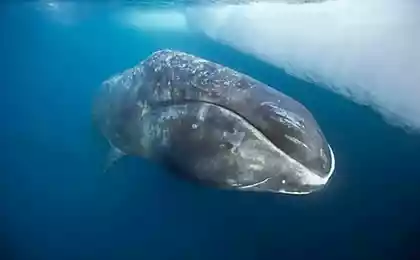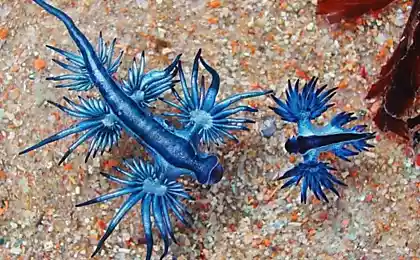903
Bright living molluscs (26 photos)
These tiny marine beauties like touch. But they are not as vulnerable as they seem: they are a dangerous weapon - poison dangerous for all living things. Photo by David Dubile
Striped 20-inch Armina seized the polyp, which is firmly attached to the ground on the main trunk of the colony of sea pen. During the battle, reminiscent of a tug of war, watching a tiny sea dog.

Extravagance their outfits may surprise even the most demanding designer, and a variety of shapes and color combinations - any artist. Despite the fact that these tiny colorful creation is not as vulnerable as it may seem at first glance.
These mollusks as small as a little finger will repulse any. Nembrotha - 6 inches
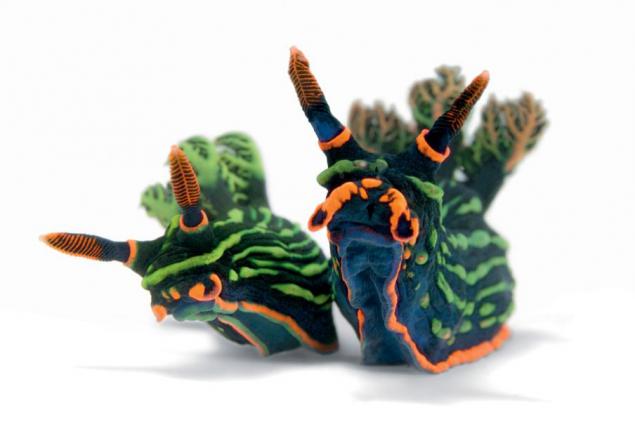
Translucent Phyllodesmium iriomotense length of 4, 3 centimeters eats only coral. Spindly gorgonian coral (pictured) - one of his favorite dishes. The digestive system is located in a clam branching tentacle appendages that can be easily discarded in case of danger.

These creatures are classified as Class gastropods, live on sandbanks and reefs, some of them are hiding in deep water. They are able to live in the cold and warm water - they can even see the bottom near the hot sources.
Bornella anguilla • 7 cm. Sensing danger, Bornella anguilla presses appendages to the torso and deftly eluded the enemy.

molluscs may drift, obeying flow. Some are even able to swim freely. But most of them prefer peace and quiet to sit on the bottom.
Glossodoris Averni • 6 cm

Clam is not given to appreciate the beauty of each other: their tiny eyes barely distinguish light. The world around us they perceive using the taste buds, olfactory and tactile
Asteronotus Cespitosus • 22 cm

Some fish, sea spiders, turtles, starfish, some species of crabs. Eat it and the people - the truth, first removing the toxic organs. Chileans and residents of the coastal islands of Russia and Alaska roast these clams, boiled and even eaten raw.
Flabellina Exoptata • 3 cm
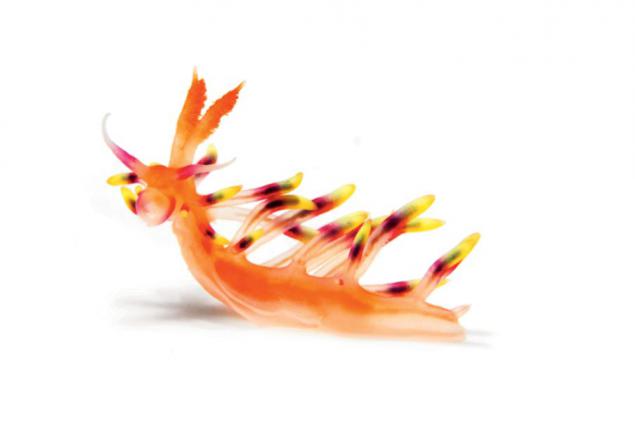
Catch them, however, not only for food. Scientists are exploring nudibranchs and their primitive nervous system, trying to understand the mechanisms of learning and memory. In addition, they study the poisons nudibranch, hoping to use their allocated substances in the pharmaceutical industry.
Cuthona sp. • 1, 8 cm
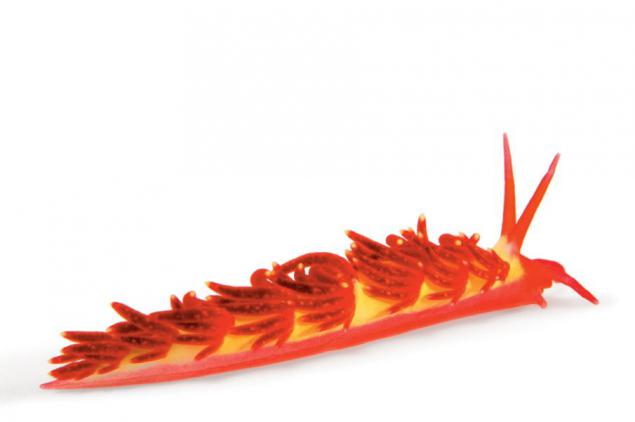
However, nudibranch people are reluctant to reveal their secrets. While only half of the described species of mollusks, and even those not well understood. Many of them do not live more than a year, and then disappear in the deep sea. So that the photos - the only thing left on the memory of their short but colorful life.
Phyllidiella Pustulosa • 6 cm
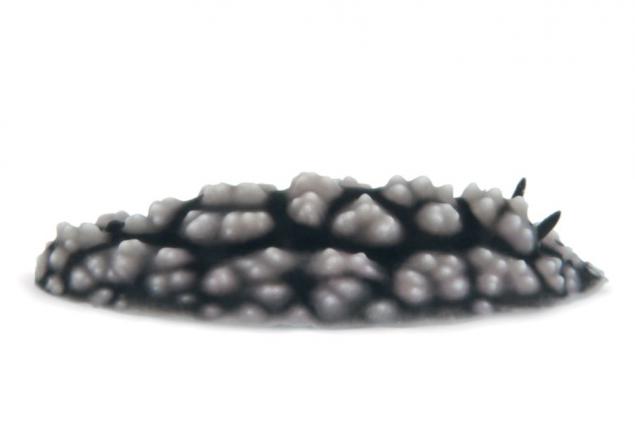
Thecacera Pacifica • 6 cm

Jorunna Funebris • 5 cm

Phyllidia Ocellata • 6 cm

Hypselodoris sp. • 5 cm
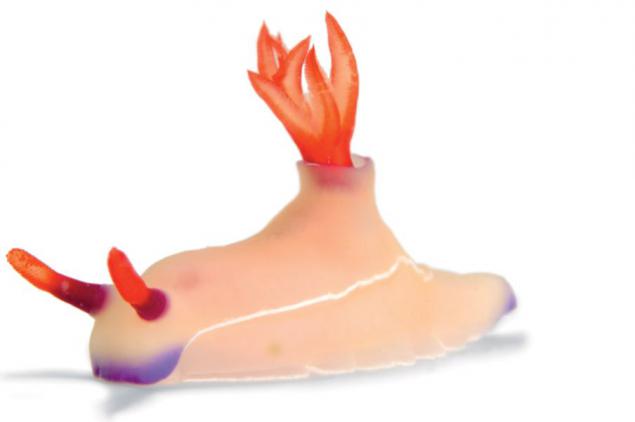
Mexichromis Mariei • 3 cm
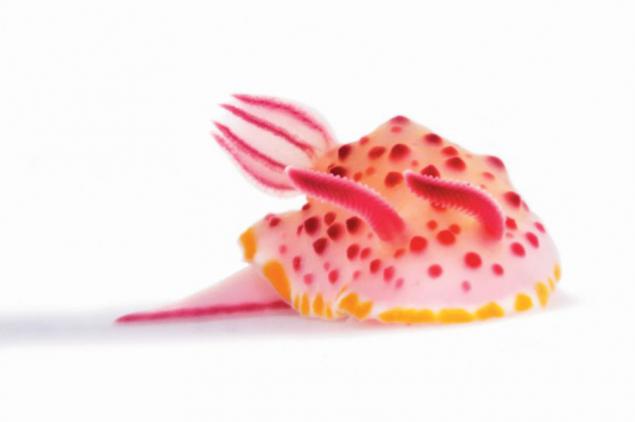
Shromodoris Dianae
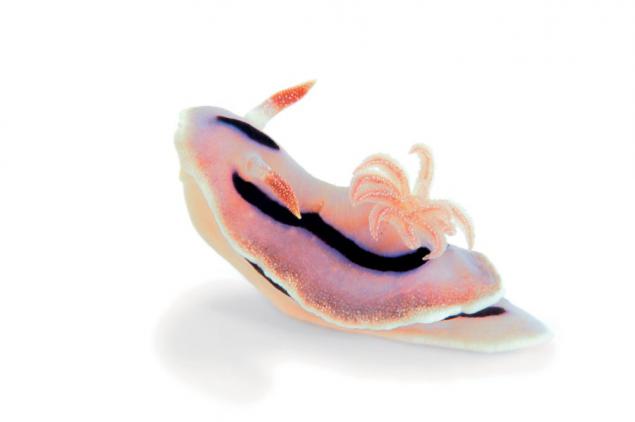
Pteraeolidia Ianthina • 15 cm
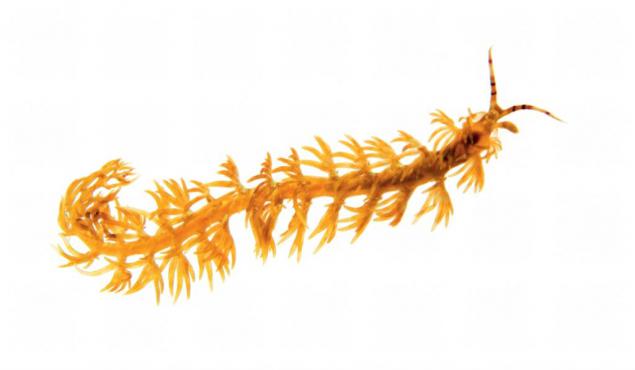
Tembrotha Sristata • 12 cm
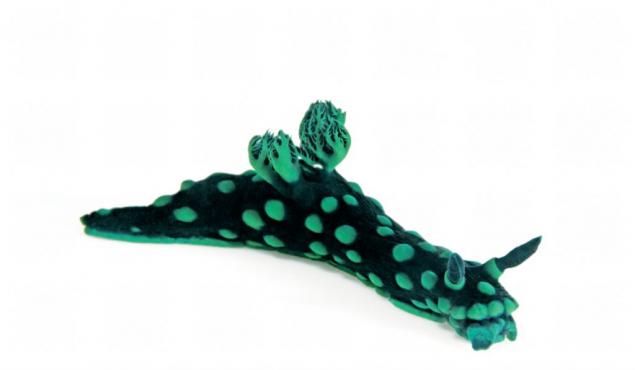
Ceratosoma Gracillimum • 12 cm
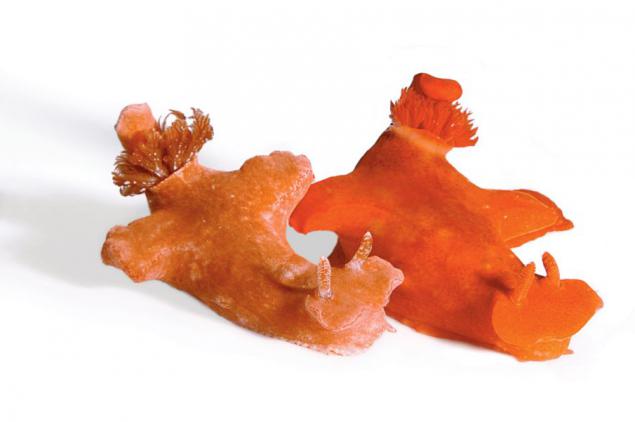
Chromodoris Geometrica • 2, 5 cm

Godiva sp. • 4 cm

Chromodoris annae • 2 cm
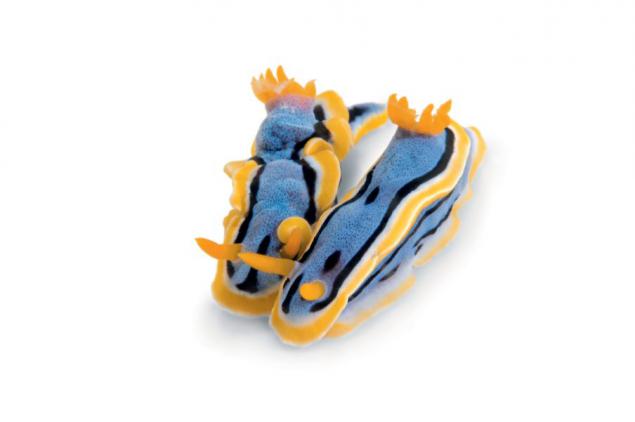
Fight for life. Mollusks of about 2, 5 centimeters Hypselodoris whitei simultaneously fertilize each other. Like all nudibranch, they are hermaphrodites, so after mating, both lay eggs.
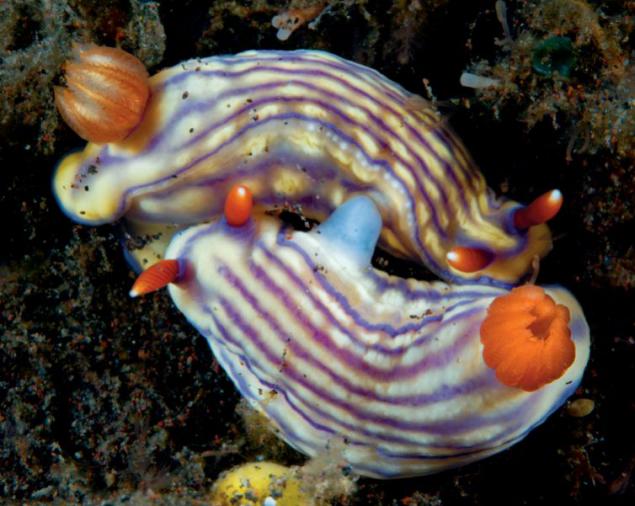
4-inch H. Kanga spins coming out of its ovipositor tape with adhesive eggs limb. Some nudibranch very picky eating habits: they prefer coral polyps everything else.
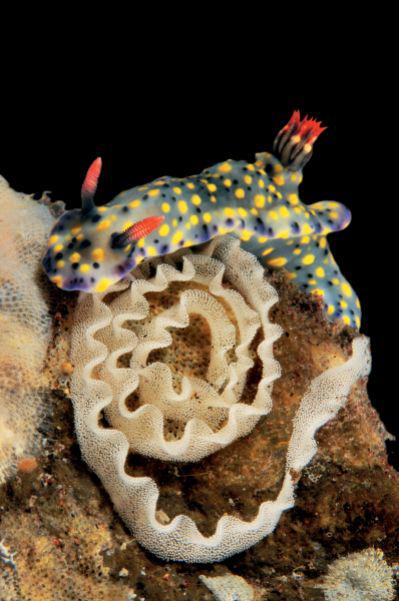
Powerful body and thick skin Halgerda Batangas - real armor. Try to see through this - to break all the teeth! And this is the surest protection against predators, which abound in the underwater world.
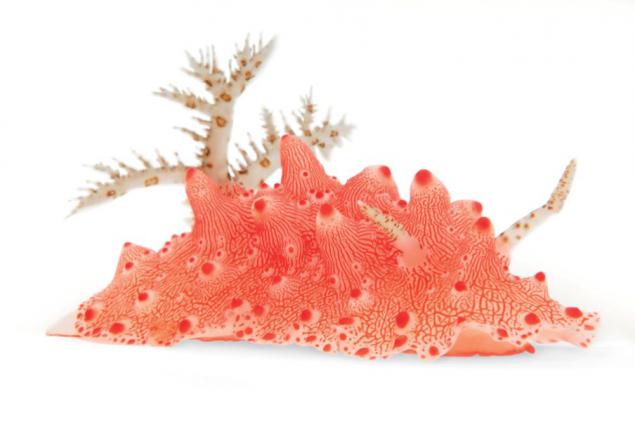
Tiny shrimp imperial Periclimenes imperator (only 1, 8 inches) often settle in the gills of dancers (above): there are safe and delicious! Are clams some benefit from your guests? This is one of the mysteries of nudibranch that only scientists to unravel.

The skirt is invisible. A wave of "skirt" - and Hexabranchus sanguineus, Spanish dancer, evade predators, disappearing into the open sea. Its portability - the envy of other sedentary nudibranch. But this is not his only talent. One side of the "skirt", camouflage, makes dancer invisible against the background of the surrounding landscape, and the other, bright, repels the enemy. By the standards of other nudibranchs, dancers - the real giants: their length - up to 45 centimeters. They feed exclusively sponges.
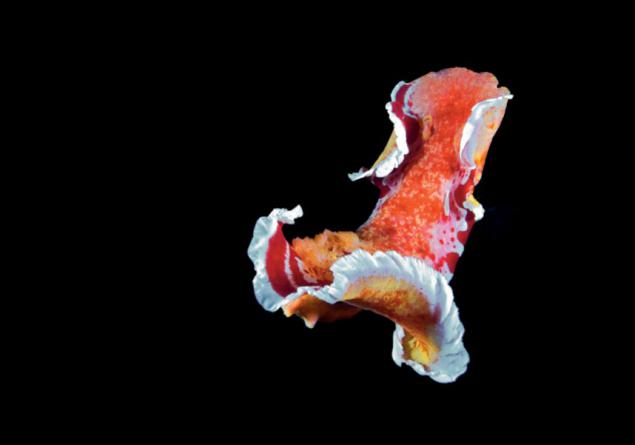
Source
Striped 20-inch Armina seized the polyp, which is firmly attached to the ground on the main trunk of the colony of sea pen. During the battle, reminiscent of a tug of war, watching a tiny sea dog.

Extravagance their outfits may surprise even the most demanding designer, and a variety of shapes and color combinations - any artist. Despite the fact that these tiny colorful creation is not as vulnerable as it may seem at first glance.
These mollusks as small as a little finger will repulse any. Nembrotha - 6 inches

Translucent Phyllodesmium iriomotense length of 4, 3 centimeters eats only coral. Spindly gorgonian coral (pictured) - one of his favorite dishes. The digestive system is located in a clam branching tentacle appendages that can be easily discarded in case of danger.

These creatures are classified as Class gastropods, live on sandbanks and reefs, some of them are hiding in deep water. They are able to live in the cold and warm water - they can even see the bottom near the hot sources.
Bornella anguilla • 7 cm. Sensing danger, Bornella anguilla presses appendages to the torso and deftly eluded the enemy.

molluscs may drift, obeying flow. Some are even able to swim freely. But most of them prefer peace and quiet to sit on the bottom.
Glossodoris Averni • 6 cm

Clam is not given to appreciate the beauty of each other: their tiny eyes barely distinguish light. The world around us they perceive using the taste buds, olfactory and tactile
Asteronotus Cespitosus • 22 cm

Some fish, sea spiders, turtles, starfish, some species of crabs. Eat it and the people - the truth, first removing the toxic organs. Chileans and residents of the coastal islands of Russia and Alaska roast these clams, boiled and even eaten raw.
Flabellina Exoptata • 3 cm

Catch them, however, not only for food. Scientists are exploring nudibranchs and their primitive nervous system, trying to understand the mechanisms of learning and memory. In addition, they study the poisons nudibranch, hoping to use their allocated substances in the pharmaceutical industry.
Cuthona sp. • 1, 8 cm

However, nudibranch people are reluctant to reveal their secrets. While only half of the described species of mollusks, and even those not well understood. Many of them do not live more than a year, and then disappear in the deep sea. So that the photos - the only thing left on the memory of their short but colorful life.
Phyllidiella Pustulosa • 6 cm

Thecacera Pacifica • 6 cm

Jorunna Funebris • 5 cm

Phyllidia Ocellata • 6 cm

Hypselodoris sp. • 5 cm

Mexichromis Mariei • 3 cm

Shromodoris Dianae

Pteraeolidia Ianthina • 15 cm

Tembrotha Sristata • 12 cm

Ceratosoma Gracillimum • 12 cm

Chromodoris Geometrica • 2, 5 cm

Godiva sp. • 4 cm

Chromodoris annae • 2 cm

Fight for life. Mollusks of about 2, 5 centimeters Hypselodoris whitei simultaneously fertilize each other. Like all nudibranch, they are hermaphrodites, so after mating, both lay eggs.

4-inch H. Kanga spins coming out of its ovipositor tape with adhesive eggs limb. Some nudibranch very picky eating habits: they prefer coral polyps everything else.

Powerful body and thick skin Halgerda Batangas - real armor. Try to see through this - to break all the teeth! And this is the surest protection against predators, which abound in the underwater world.

Tiny shrimp imperial Periclimenes imperator (only 1, 8 inches) often settle in the gills of dancers (above): there are safe and delicious! Are clams some benefit from your guests? This is one of the mysteries of nudibranch that only scientists to unravel.

The skirt is invisible. A wave of "skirt" - and Hexabranchus sanguineus, Spanish dancer, evade predators, disappearing into the open sea. Its portability - the envy of other sedentary nudibranch. But this is not his only talent. One side of the "skirt", camouflage, makes dancer invisible against the background of the surrounding landscape, and the other, bright, repels the enemy. By the standards of other nudibranchs, dancers - the real giants: their length - up to 45 centimeters. They feed exclusively sponges.

Source









